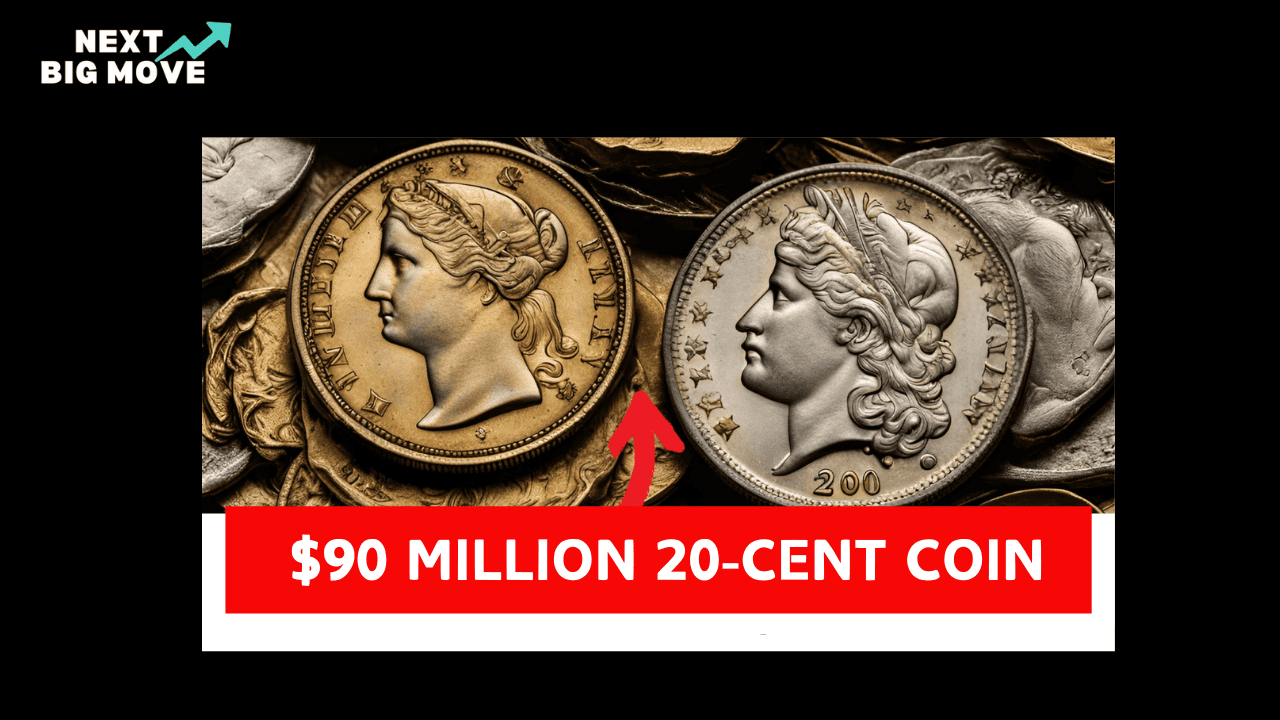In the world of numismatics, the fascination with rare and valuable coins never fades. One of the most talked-about legends is that of a 20-cent coin worth an astounding $90 million. But is this true or simply an exaggerated tale? Let’s break down the story of the 20-cent piece, its history, and what makes it valuable to collectors, while debunking some of the myths surrounding its worth.
The Brief but Intriguing History of the 20-Cent Coin
The 20-cent coin, often referred to as the “double dime,” was introduced in 1875. It was designed to bridge the gap between the dime and the quarter, particularly in western states where Spanish and Mexican coins were still in circulation. However, its size was too similar to the quarter, causing confusion in everyday transactions. As a result, this coin was minted for just three years, from 1875 to 1877, before it was discontinued in 1878 due to its lack of popularity.
Key facts about the 20-cent piece:
- Minted only for three years: 1875, 1876, and 1877
- Approximately 1.35 million coins were minted
- Produced in three mints: Philadelphia, Carson City, and San Francisco
- Officially demonetized in 1878, making it a rare artifact today
The short lifespan of the 20-cent coin, combined with its limited mintage, makes it a highly sought-after piece among collectors. However, the myth of the coin’s astronomical $90 million value doesn’t hold water upon closer inspection.
20-Cent Coin Rarity and Value: What You Need to Know
While the claim that a 20-cent coin is worth $90 million is almost certainly a myth, these coins do hold considerable value. The most prized examples come from the Carson City mint, particularly the 1876-CC issue, known for its rarity and historical significance.
Notable auction sales:
- In 2013, an 1876-CC 20-cent piece, graded MS-65 by PCGS, sold for $564,000 at an auction.
- Well-preserved coins from other mints or years have also sold for impressive sums, though nowhere near the $90 million mark.
Even coins in fair condition, though not as rare or pristine, can fetch several thousand dollars. While these numbers are impressive, they pale in comparison to the eye-catching $90 million claim. So where did this figure originate?
The Origins of the $90 Million Myth
The story of the $90 million 20-cent coin likely stems from a mix of factors:
- Misinterpretation of news about rare coin sales, where figures from other rare coins may have been mistakenly attributed to the 20-cent piece.
- Confusion with more valuable coins, such as the 1794 Flowing Hair Silver Dollar, which sold for over $10 million in 2013, or the 1933 Double Eagle, a $20 gold coin that fetched $18.9 million in 2021.
- Exaggeration for sensationalism or clickbait purposes, where the true value of the coin is inflated to attract attention.
- The human tendency to embellish stories, leading to the creation of urban legends that get more exaggerated over time.
In truth, no 20-cent coin has ever been valued anywhere near $90 million. While this myth has persisted, it’s important for collectors and enthusiasts to remain grounded in reality when appraising these coins.
Factors that Affect the Value of a 20-Cent Coin
Several critical factors influence the value of a 20-cent piece, and understanding these elements is key to identifying potential treasures:
- Mintage Year and Mint Mark: The 1876-CC is the most valuable due to its low mintage and the historic significance of the Carson City mint. Other rare examples include the 1875-S/CC, a San Francisco mint coin with a repunched Carson City mint mark.
- Condition: Coins in mint state (MS-60 or higher) can be worth significantly more than those that show signs of heavy circulation.
- Rarity: The fewer examples of a particular coin in good condition, the higher its value. A coin that has survived for over a century in pristine condition is exceedingly rare and valuable.
- Historical Significance: Coins like the 20-cent piece, which were short-lived and reflect a unique chapter in American history, are more valuable due to their historical context.
- Market Demand: As with any collectible, the demand for rare coins can fluctuate. If interest in numismatics rises, so too does the potential value of these coins.
How to Identify a Valuable 20-Cent Piece
If you suspect you have a valuable 20-cent coin, here’s what to look for:
- Date and Mint Mark: Check the year (1875, 1876, or 1877) and mint mark. The “CC” mark indicates a coin minted in Carson City, while “S” denotes the San Francisco mint. A lack of a mint mark signifies Philadelphia.
- Condition: Look for coins with minimal wear, sharp details, and a strong luster. Well-preserved coins are significantly more valuable.
- Authenticity: Beware of counterfeits. If you think you have a valuable coin, consult a professional numismatist to verify its authenticity.
Other Valuable Coins in the World of Numismatics
While the 20-cent piece is a fascinating example of rare coinage, it’s not the only coin to fetch millions. Some of the most valuable coins in history include:
- 1794 Flowing Hair Silver Dollar: Sold for over $10 million in 2013, this coin is one of the most iconic in American numismatics.
- 1933 Double Eagle: This $20 gold coin made headlines when it sold for $18.9 million in 2021.
- 1943 Copper Lincoln Cent: This rare cent, produced by mistake, sold for $1.7 million in 2010.
- 1804 Silver Dollar: Known as the “King of American Coins,” specimens of this coin have sold for millions due to its extreme rarity and historical importance.
The Appeal of Coin Collecting
Coin collecting, also known as numismatics, holds immense appeal beyond just monetary value. It’s a hobby that offers numerous rewards:
- Historical Connection: Coins provide a tangible link to the past, allowing collectors to connect with history and gain insights into economic, political, and cultural contexts.
- Artistic Appreciation: Many coins, including the 20-cent piece, feature intricate designs that reflect the artistic sensibilities of their time.
- Investment Potential: Though rare, coins can appreciate in value over time, making them a solid investment for some collectors.
- The Thrill of the Hunt: For many, the search for a rare coin is as exciting as owning it. The journey of discovery can be a rewarding experience in itself.
- Community: Numismatics offers a vibrant community of enthusiasts who share knowledge and foster connections through coin shows, auctions, and online forums.
Tips for Aspiring Coin Collectors
If you’re considering diving into the world of rare coins, here are some tips to help you get started:
- Educate Yourself: Learn about coin grading, mintage figures, and market trends. Books, online resources, and numismatic societies can be great sources of knowledge.
- Start Small: Begin with more affordable and common coins. As you gain experience, you can move on to rarer and more valuable pieces.
- Buy from Reputable Dealers: Always purchase coins from trusted dealers or auction houses that provide authentication and fair pricing.
- Protect Your Investment: Proper storage is essential to maintaining the condition and value of your coins. Use protective holders to prevent damage.
- Join Numismatic Organizations: Connect with other collectors, attend shows, and stay updated on the latest market trends through numismatic societies.
The Real Value of Coin Collecting
While the dream of finding a $90 million coin is thrilling, the reality of coin collecting is often more grounded but equally rewarding. Rare coins can fetch impressive sums, but most valuable coins are far from easy to come by. Even if your coins don’t make you a millionaire, the joy of uncovering rare pieces, learning about history, and joining a passionate community of collectors makes it all worthwhile.
As you explore the world of numismatics, remember that the true value of coins lies not just in their monetary worth but in the stories they tell and the connections they provide to the past.
In the end, whether you stumble upon a priceless treasure or simply enjoy the pursuit of knowledge, coin collecting is an enriching journey that rewards enthusiasts in more ways than one. Keep your eyes peeled—who knows, the next great find could be waiting in your pocket change!
Also Read: Hidden Treasure in Your Pocket: Rare $1 Coin Could Be Worth $10 Million

